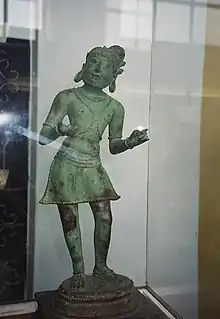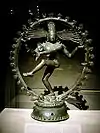Nayanars
The Nayanars (or Nayanmars; Tamil: நாயன்மார், romanized: Nāyaṉmār, lit. 'hounds of Siva', and later 'teachers of Shiva )[1] were a group of 63 Tamil Hindu saints living during the 6th to 8th centuries CE who were devoted to the Hindu god Shiva. Along with the Alvars, their contemporaries who were devoted to Vishnu, they influenced the Bhakti movement in early medieval South India.[2] The names of the Nayanars were first compiled by Sundarar. The list was expanded by Nambiyandar Nambi during his compilation of material by the poets for the Tirumurai collection, and would include Sundarar himself and Sundarar's parents.

The Nalvar (lit. 'The Four') are the four foremost Nayanars Appar, Sundarar, Sambandar and Manikkavaasagar.[3]
History
The list of the Nayanars was initially compiled by Sundarar (Sundararmurthi). In his poem Tiruthonda Thogai he sings, in eleven verses, the names of the Nayanar saints up to Karaikkal Ammaiyar, and refers to himself as "the servant of servants".[2][4][5] The list did not go into the detail of the lives of the saints, which were described in detail in works such as Tevaram.[6]
In the 10th century, king Raja Raja Chola I collected the volumes of Tevaram after hearing excerpts of the hymns in his court.[7]: 50 His priest Nambiyandar Nambi began compiling the hymns into a series of volumes called the Tirumurai. He arranged the hymns of three saint poets Sambandar, Appar and Sundarar as the first seven books which he called the Tevaram. He compiled Manikkavasakar's Tirukovayar and Tiruvasakam as the eighth book, the 28 hymns of nine other saints as the ninth book, the Tirumandiram of Tirumular and 40 hymns by 12 other poets as the tenth book. In the eleventh book, he created the Tirutontanar Tiruvanthathi (also known as Tirutoṇṭar Antādi, lit. Necklace of Verses on the Lord's Servants), which consisted of 89 verses, with a verse devoted to each of the saints. With the addition of Sundarar and his parents to the sequence, this became the canonical list of the 63 saints.[6] In the 12th century, Sekkizhar added a twelfth volume to the Tirumurai called Periya Puranam in which he expands further on the stories of each of 63 Nayanars.[1][2][4]
The Nayanars were from various backgrounds, including Channar, Vanniyar, Vellalas, Idayars, Kurumbars, Thevars, oilmongers, Brahmins, Vannar, and Dalits.[1] Along with the twelve Vaishnava Alvars, they are regarded as the important Hindu saints from South India.
Many Kannada works, such has Nambiyannana Ragale and Tiru Nilakanta Devara Ragale, are written on Nayanars by Kannada poet Harihara. Sundara Murthy nayanar is known as Nambiyanna in Kannada literature.
List of Nayanars


Sundarar's original list of Nayanars did not follow any sequence with regards to chronology or importance. However, some groups have since followed an order for arranging their Nayanar temple images according to Sundarar's poem as well as the information from Nambi and Sekkizhar.[4][8]
| Part of a series on |
| Shaivism |
|---|
 |
|
|
| No.[8] | Person | Notes |
|---|---|---|
| 1 | Sundarar | Born in Aadi month, Swathi nakshathiram |
| 2 | Tiru Neelakanta | |
| 3 | Iyarpagaiar | His name "Iyarpagai" means "Contrary to Nature" |
| 4 | Ilayankudi Maranar | |
| 5 | Meiporul | |
| 6 | Viralminda | |
| 7 | Amaraneedi | |
| 8 | Eripatha | |
| 9 | Yenathinathar | A Brave swordsman/general in Chola Military |
| 10 | Kannappa | Believed to be a reincarnation of Arjuna |
| 11 | Kungiliya Kalaya | |
| 12 | Manakanchara | |
| 13 | Arivattaya | |
| 14 | Anaya | |
| 15 | Murthiyar | |
| 16 | Muruga | |
| 17 | Rudra Pasupathi | |
| 18 | Nandanar (Thirunalai Povar) | |
| 19 | Tiru Kurippu Thonda | |
| 20 | Chandeshvara | |
| 21 | Appar (Tirunavukkarasar) | His efforts convinced the Pallava king, Mahendra- Varman I to take up Shaivism. |
| 22 | Kulachirai | He became the Prime Minister of the Pandyan King Koon Pandiyan. |
| 23 | Perumizhalai Kurumba | |
| 24 | Karaikkal Ammeiyar | Nagarathar Woman saint who lived in the 6th century[9] |
| 25 | Apputhi Adigal | |
| 26 | Tiruneelanakka | |
| 27 | Nami Nandi Adigal | |
| 28 | Sambandar | A child prodigy Saiva Saint who lived only 16 years |
| 29 | Eyarkon Kalikama | |
| 30 | Tirumular | |
| 31 | Dandi Adigal | |
| 32 | Murkha | |
| 33 | Somasi Mara | |
| 34 | Sakkiya | |
| 35 | Sirappuli | |
| 36 | Siruthondar | Army general of the Pallava king Narasimavarman I |
| 37 | Cheraman Perumal | Tentatively identified with Chera ruler Rama Rajasekhara[10]
Born in Aadhi month, Swathi nakshathiram |
| 38 | Gananatha | |
| 39 | Kootruva | |
| 40 | Pugal Chola | Chola King |
| 41 | Narasinga Muniyaraiyar | |
| 42 | Adipaththar | |
| 43 | Kalikamba | |
| 44 | Kalia | Born in Aadhi month, Kettai nakshathiram |
| 45 | Satti | |
| 46 | Aiyadigal Kadavarkon | |
| 47 | Kanampulla | |
| 48 | Kari | |
| 49 | Ninra Seer Nedumaara | Pandya King |
| 50 | Mangayarkkarasiyar | Queen and consort of Nindra Seer Nedumaran |
| 51 | Vayilar | |
| 52 | Munaiyaduvar | |
| 53 | Kazharsinga | Tentatively identified with Pallava king Narasimhavarman II (Rajasimha) |
| 54 | Idangazhi | |
| 55 | Seruthunai | |
| 56 | Pugazh Thunai | |
| 57 | Kotpuli | |
| 58 | Pusalar | |
| 59 | Nesa Nayanar | Saliyar, weaver who donates clothes to Lord Shiva's devotees |
| 60 | Sengenar (Kochengat Chola) | |
| 61 | Tiru Nilakanta Yazhpanar | |
| 62 | Sadaiya | Sundarar's father |
| 63 | Isaignaniyaar | Sundarar's mother |
Other saints
The 9th-century poet Manikkavacakar was not counted as one of the 63 Nayanars but his works were part of the eighth volume of the Tirumurai.
In Tiruchuli, the Tamil poet-philosopher Valluvar is worshipped as the 64th Nayanar.[11] Valluvar was also added as the 64 saint in the annual Mylapore procession of the 63 Nayanars since c. 1905.[12][13]
See also
References
- Sadasivan, S. N. (2000). A Social History of India. New Delhi: A.P.H. Publishing Corporation. pp. 150–151. ISBN 81-7648-170-X.
- Ramaswamy, Vijaya (2007). Historical Dictionary of the Tamils. Scarecrow Press. p. 167. ISBN 978-0-8108-6445-0.
- "Who Were the Nalvars? – Saivite Scriptures". Retrieved 13 March 2022.
- Sivananda, Swami. "Sixty-Three Nayanar Saints". The Divine Life Society Uttar Pradesh. 19. Tiru Kurippu Thonda Nayanar. Archived from the original on 23 November 2019.
- Mahadevan, T. M. P. (1971). Ten Saints of India (3rd ed.). Bombay: Bharatiya Vidya Bhavan. p. 35. LCCN 70-924698.
- Zvelebil, Kamil (1974). Tamil Literature. A History of Indian Literature. Vol. 10. Wiesbaden: Otto Harrasowitz. p. 130. ISBN 3-447-01582-9.
- Cutler, Norman (1987). Songs of Experience: The Poetics of Tamil Devotion. Bloomington: Indiana University Press. ISBN 0-253-35334-3.
- Vanmikanathan, G. "The Sixty-Three Nayanars". Skandagurunatha.org. Archived from the original on 30 September 2019. Retrieved 20 April 2020.
- Das, Sisir Kumar (2005). A History of Indian Literature, 500-1399: From Courtly to the Popular. Chennai: Sahitya Akademi. p. 31. ISBN 81-260-2171-3.
- Karashima, Noboru, ed. (2014). "States in Deccan and Kerala". A Concise History of South India: Issues and Interpretations. Oxford University Press. pp. 146–47. ISBN 978-0-19-809977-2.
- Kannan, Kaushik (11 March 2013). "Saint poet's guru pooja at Tiruchuli". The New Indian Express. Tiruchuli: Express Publications. Retrieved 3 September 2020.
- Karthik Bhatt (16–31 March 2020). "Arupathu Moovar – 110 years ago". Madras Musings. XXIX (23).
- Pradeep Chakravarthy; Ramesh Ramachandran (16–31 August 2009). "Thiruvalluvar's shrine". Madras Musings. 19 (9).
Further reading
- Cort, John E. (1998). Open Boundaries: Jain Communities and Culture in Indian History. Albany: State University of New York Press. ISBN 0-7914-3786-8.
External links
- "63 Nayanmarkal". Shaivam.org.
